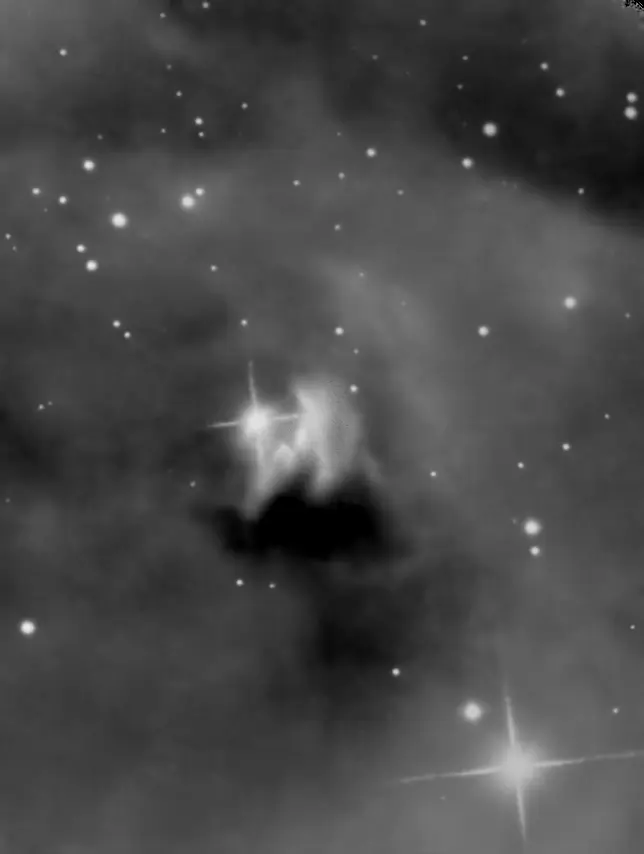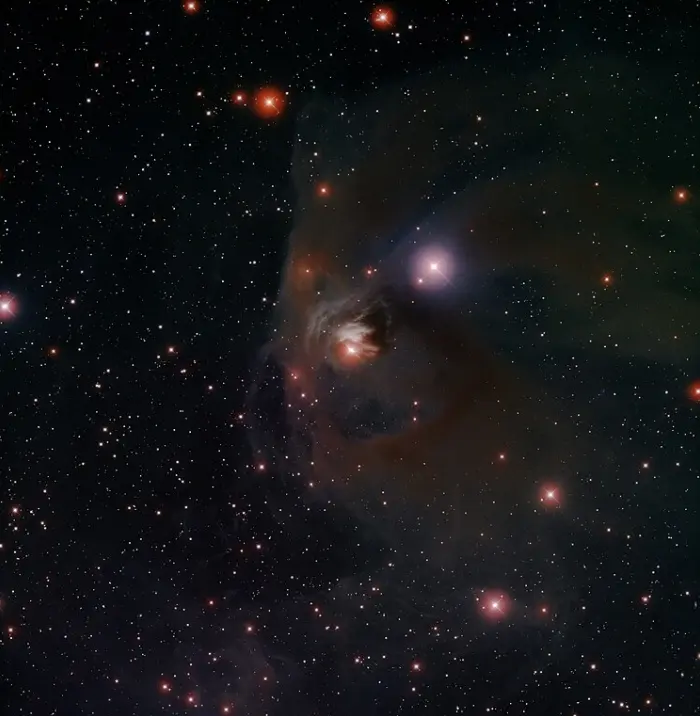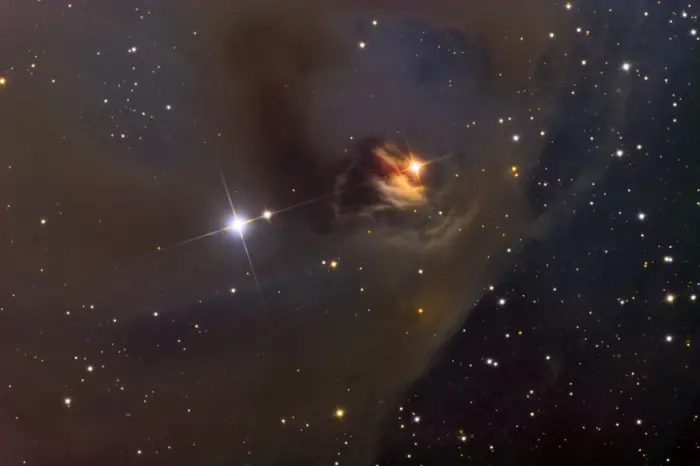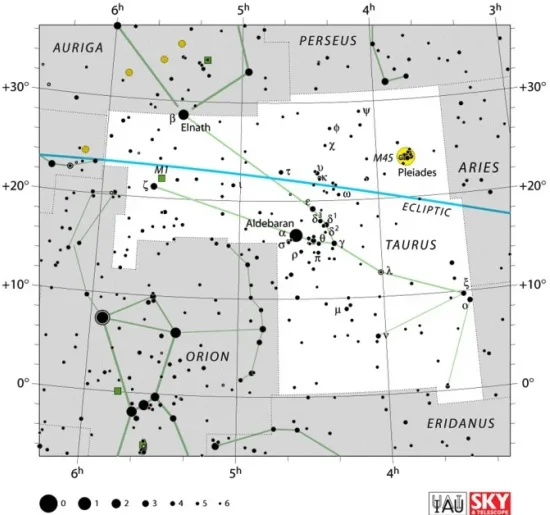T Tauri is a young variable star located 471 light-years away in the northern constellation Taurus. With an apparent magnitude of 10.27, it is not visible to the unaided eye. The star serves as the prototype for a class of pre-main sequence stars known as the T Tauri variables. It illuminates Hind’s Variable Nebula (NGC 1555), a reflection nebula that varies in brightness and appearance due to the star’s variability.
Star system
T Tauri is a star system composed of three young stellar objects, designated T Tauri North (T Tau N), T Tauri South A (T Tau Sa) and T Tauri South B (T Tau Sb).
T Tauri North is visible in the optical band because its accretion disk appears almost perpendicular to our line of sight, while the T Tauri S binary can be detected in the infrared, but not in visible light. The system is surrounded by material from its birth cloud, indicating that it is still in an early stage of evolution.
T Tauri North and T Tauri South are separated by about 300 astronomical units, while the separation between the two components of T Tauri South is around 7 astronomical units. T Tauri Sa and Sb have an orbital period of 27.2 ± 0.7 years, and the orbital period of T Tauri N and T Tauri S is uncertain, with estimates in the range between 400 and 14,000 years.
T Tauri N has a mass of around 2.1 solar masses. The star’s mass was estimated based on its effective temperature in the optical band and stellar evolutionary models.

T Tauri, image (cropped): Adam Block/Mount Lemmon SkyCenter/University of Arizona (CC BY-SA 3.0)
However, high-resolution near-infrared observations found a significantly lower photospheric temperature and an unusually low surface gravity, indicating that T Tauri N is both younger and less massive than previously believed. Even though it is the prototype for the class of T Tauri stars, the evolutionary state of the system is not fully understood.
T Tauri N has the spectrum of a Classic T Tauri star, but it is not one in terms of evolution. It is believed to still be a protostar, one that was ejected from its birth cloud within the past few thousand years. The star is still gravitationally bound to the other two components.
The protostar phase precedes the pre-main sequence phase (T Tauri phase). It begins when a core forms inside a collapsing fragment of a molecular cloud and ends when the infalling gas is depleted. Protostars normally cannot be detected at optical wavelengths because they are embedded in thick dust clouds, and their radiation is absorbed by the dust. T Tauri North is visible because it was expelled from the dust cloud shortly after its formation.
T Tauri South has a total mass of around 2.5 – 2.7 solar masses. T Tauri Sa is the most massive of the three stars in the T Tauri system. It has a mass of 2.0 – 2.3 solar masses. T Tauri Sb is considerably less massive, with a mass of 0.4 – 0.5 solar masses.
The components are believed to be in the T Tauri phase of evolution. They are not sufficiently evolved to undergo nuclear fusion in their cores. They vary in brightness as they accrete matter from the surrounding clouds.
The accretion of material produces jets, which form due to magnetic fields in the accretion disk. The jets and mass outflows remove a fraction of the angular momentum from the system.
The outflows created by the three components are not well understood. Astronomers have observed two bipolar outflows – one from T Tauri N and the other from T Tauri S – that appear to be interacting. The interaction is expected to become more intense as the system evolves.
T Tauri has been observed to vary in brightness from the peak magnitude of about 9.5 to fainter than detection limits on photographic plates.
T Tauri South can be observed in the infrared band. It appears very red, and its brightness varies at all near-infrared and mid-infrared wavelengths. The variability is believed to be caused by either the material in the circumbinary ring, which is not uniform, or by the individual components flaring up as they accumulate material.
In 2021, a team of astronomers led by Masayuki Yamaguchi of the Department of Astronomy, University of Tokyo, and the National Astronomical Observatory of Japan, observed the protoplanetary disk of T Tauri with the Atacama Large Millimeter/submillimeter Array (ALMA) in the Atacama Desert of Northern Chile. They reported an annular gap structure 12 astronomical units from the star. The gap may be caused by an embedded Saturn-mass planet.

Timelapse of NGC1555 variable nebula activity over approximately 6 months through Oct 2022 to March 2023, using data from contributors of the Big Amateur Telescope. Image credit: Wikimedia Commons/Danreind (CC BY-SA 4.0)
T Tauri stars
T Tauri stars are a class of young low-mass pre-main sequence stars that are still accreting material from their parent clouds. These young stellar objects are less than 10 million years old and lie near star-forming regions. They are in the process of contracting to the main sequence.
When they reach the pre-main sequence phase, young stellar objects have accreted almost all their mass, but they have not yet started hydrogen burning. As they continue to contract, their internal temperature rises until they begin to fuse hydrogen on the zero-age main sequence.
Pre-main sequence stars with a mass of less than about 2 – 3 solar masses are called T Tauri stars, while more massive ones (2 – 8 solar masses) are called Herbig Ae/Be stars. Like all low-mass stars, our Sun was a T Tauri star in the early stages of its existence. The most massive protostars (>8 solar masses) do not go through the pre-main sequence phase; by the time they emerge from their parent clouds, they are already fusing hydrogen and they are main sequence stars.
T Tauri stars evolve into main sequence stars of spectral types F, G, K and M. They have similar surface temperatures to main sequence stars of the same mass but are much more luminous because they are larger. Unlike main sequence stars, which produce energy through nuclear fusion processes in their cores, T Tauri stars are powered by gravitational energy that is released as they contract.
Most of the known T Tauri stars are found in binary systems. About half of them have circumstellar disks (protoplanetary disks) in which planets and planetary systems may eventually form.
The T Tauri class was initially defined by the American astronomer Alfred Harrison Joy in 1945. Joy observed eleven irregular variable stars with irregular light variations of about 3 magnitudes, low luminosity, spectral types of F5 – G5 with emission lines similar to the solar chromosphere, and located near dark or bright nebulae. He identified these irregular variables as a new class whose prototype was T Tauri. He published his findings in The Astrophysical Journal, vol. 102.
Hind’s Variable Nebula
T Tauri illuminates the reflection nebula NGC 1555, also known as Hind’s Variable Nebula. Hind’s Variable Nebula is the most distinctive of three Herbig-Haro objects near the young star system. It appears about an arcminute west of T Tauri. The nebula has a similar spectrum to the star and its brightness varies because material occasionally comes between it and T Tauri.
Another patch of nebulosity appears close to the star. It is catalogued as HH 255 and known as Burnham’s Nebula or Cederblad 32c. The nebula was named after its discoverer, the American astronomer Sherburne Wesley Burnham, who spotted it using the Great Lick Refractor at the Lick Observatory in 1890.

T Tauri is a famous variable star in the constellation of Taurus. In this image, it is the star at the center of the image, embedded in dust and gas. The nebula itself is known as NGC 1555. T Tauri is the prototype for a class of stars (known collectively as “T Tau stars”) that are notable because they are very young stars in the process of forming. These stars have just recently emerged from the dense dust and gas “cocoons” from which they formed. Image credit: T. A. Rector/University of Alaska Anchorage, H. Schweiker/WIYN and NOIRLab/NSF/AURA (CC BY 4.0)
The third Herbig-Haro object associated with T Tauri is HH 355. It consists of two lobes, HH 355 North and HH 355 South, each of which contain three major patches. The giant outflow stretches almost 1.5 parsecs away from T Tauri and may have been produced when T Tauri North was expelled from a closer orbit with T Tauri South. The patches were produced in pairs. The first pair was created about 5,000 years ago, followed by the second pair 900 years later, and the third pair 900 years after the second.
In 1868, Baltic German astronomer Otto Wilhelm von Struve found another patch of nebulosity about 4 arcminutes west of T Tauri. His discovery was confirmed by Heinrich Ludwig d’Arrest. Over the next couple of decades, Struve’s Nebula disappeared from view. Even though it was later included in the New General Catalogue as NGC 1554, the nebula has not been seen since the mid-19th century and is now commonly referred to as Struve’s Lost Nebula.
Struve’s Lost Nebula may be part of the larger complex of reflection nebulae surrounding the T Tauri system, or it may be illuminated by a star that experiences flares only rarely.

T Tauri and NGC 1555, image credit: Adam Block/Mount Lemmon SkyCenter/University of Arizona (CC BY-SA 3.0)
Facts
T Tauri and Hind’s Variable Nebula (NGC 1555) were discovered by the English astronomer John Russell Hind in October 1852.
T Tauri lies in the Taurus-Auriga complex, a nearby region of low-mass star formation. The star is a member of the Taurus-Auriga association, a family of young stars that formed in the same molecular cloud within the last 2 million years. T Tauri North is one of the brightest T Tauri stars in the Taurus-Auriga association.
T Tauri South was discovered by H. M. Dyck, T. Simon, and B. Zuckerman using NIR speckle interferometry in 1982. The astronomers reported a north-south separation of 0.61 ± 0.04 arcseconds and a total separation of 145 ± 10 astronomical units between T Tauri N and S, as well as very different colours of the components. The separation is now believed to be around 300 AU.
T Tauri South was discovered to be a binary system by American astronomer Christopher Duro Koresko in 1997. Koresko reported his discovery in 2000, noting a projected spatial separation 7 astronomical units, corresponding to an angular separation of 0.05 arcseconds, between the components at the time of discovery.
The system is listed as WDS J04220+1932AB in the Washington Double Star Catalog.
Name
T Tauri does not have a formal name. It is commonly referred to by its variable star designation. These identifiers are similar to Bayer designations in that they use the genitive form of the host constellation. However, instead of a single Greek or Latin letter, variable star designations have one or two Latin letters (e.g. Y Canum Venaticorum, VY Canis Majoris, UY Scuti) or a V followed by a number (e.g. V838 Monocerotis).
T Tauri South is also referred to T Tauri IRC (infrared companion).
Location
T Tauri appears in the same line of sight as the Hyades, a bright open cluster visible to the unaided eye. However, the star is not a member of the Hyades. It lies about 420 light-years behind it. It appears close to Ain (Epsilon Tauri), one of the stars that mark the Bull’s eyes (the other is Aldebaran).
Aldebaran and the Hyades can be found by extending a line from the three stars of Orion’s Belt to the northwest. Aldebaran appears as the brightest member of the Hyades, but it lies much closer to us and is not associated with the cluster. The V-shaped cluster outlines the head of the celestial Bull.

The location of T Tauri, image: Stellarium
Shining at magnitude 3.53, Ain is visible from areas without too much light pollution. It is the star at the other end of the V from Aldebaran.

T Tauri location, image: Stellarium
Constellation
T Tauri is located in the constellation Taurus. Representing the Bull, Taurus is one of the 12 zodiac constellations, which appear on the ecliptic (the Sun’s apparent path across the sky). The constellation also lies on the celestial equator and is visible from all but the northernmost and southernmost places on Earth for at least part of the year.
Taurus is one of the Greek constellations catalogued by the Greek astronomer Ptolemy in his Almagest in the 2nd century CE. It is one of the oldest constellations in the sky, along with the neighbouring Orion.
In Greek mythology, Taurus is associated with the god Zeus, who assumed the form of a white bull to seduce and abduct the princess Europa. The constellation is also sometimes taken to represent Io, a princess whom Zeus turned into a heifer to protect her from his jealous wife Hera.
Taurus occupies 797 square degrees of the predominantly northern sky and is the 17th largest constellation in the sky. The Bull’s head is represented by the bright, large Hyades, while the Pleiades cluster marks its shoulder. The Hyades and the Pleiades are the brightest and nearest open clusters to the solar system.

Taurus constellation map by IAU and Sky&Telescope magazine
The Bull’s horns are marked by Elnath (Beta Tauri) and Tianguan (Zeta Tauri). Elnath forms Auriga’s hexagon with Capella and other bright stars of the constellation Auriga, and Tianguan lies between Elnath and Betelgeuse and appears close to the Crab Nebula, the bright remnant of a historic supernova.
The orange giant Aldebaran, the brightest star in Taurus, is the 14th brightest star in the sky. It shines at magnitude 0.86 from a distance of 65.3 light-years.
Other notable stars in the constellation include the blue giant Elnath (Beta Tauri), the orange giant Ain (Epsilon Tauri), the wide double star Chamukuy (Theta Tauri), the eclipsing variable star Lambda Tauri at the Bull’s chest, and the hot blue giant Tianguan (Zeta Tauri), which forms a spectroscopic binary pair with a smaller companion. Chamukuy and Ain are the brightest Hyades stars.
The brightest stars in the Pleiades cluster – Alcyone, Atlas, Electra, and Maia, among others – are also visible without binoculars. These stars are evolved blue giants much more massive and luminous than the Sun.
The best-known deep sky objects in Taurus are the Pleiades (Messier 45), the Hyades (Caldwell 41) and the Crab Nebula (Messier 1). Other deep sky objects in the constellation include the Crystal Ball Nebula (NGC 1514), Hind’s Variable Nebula (NGC 1555), Tempel’s Nebula (NGC 1435) near Merope, the Spaghetti Nebula (Simeis 147), the active galaxy Markarian 1506 (3C 120), and the interacting pair of galaxies NGC 1409 and NGC 1410.
Taurus is visible throughout the winter months in the northern hemisphere. The best time of the year to observe the stars and deep sky objects in the constellation is during the month of January, when the celestial Bull is high above the horizon in the evening. The entire constellation can be seen from locations north of the latitude 65° S.
The 10 brightest stars in Taurus are Aldebaran (Alpha Tau, mag. 0.86), Elnath (Beta Tau, mag. 1.65), Alcyone (Eta Tau, mag. 2.87), Tianguan (Zeta Tau, mag. 2.97), Chamukuy (Theta2 Tauri, mag. 3.40), Lambda Tauri (mag. 3.47), Ain (Epsilon Tau, mag. 3.53), Omicron Tauri (mag. 3.61), Atlas (27 Tau, mag. 3.63), and Prima Hyadum (Gamma Tau, mag. 3.654).
T Tauri
| Spectral class | G5V:e |
| Variable type | T Tauri |
| U-B colour index | +0.80 |
| B-V colour index | +1.22 |
| Apparent magnitude | 10.27 |
| Distance | 471 ± 4 light-years (144 ± 1 parsecs) |
| Parallax | 6.8901 ± 0.0377 mas |
| Radial velocity | +23.90 ± 1.5 km/s |
| Proper motion | RA: + 11.682 ± 0.052 mas/yr |
| Dec.: -14.341 ± 0.038 mas/yr | |
| Mass | 2.12 ± 0.10 M☉ (T Tau Sa), 0.53 ± 0.06 M☉ (T Tau Sb) |
| Age | 0.4 million years (T Tauri Sa) |
| Constellation | Taurus |
| Right ascension | 04h 21m 59.4319873992s |
| Declination | +19° 32′ 06.432393336″ |
| Names and designations | T Tauri, HD 284419, HIP 20390, BD+19° 706, AG+19° 341, GCRV 2524, GSC 01272-00470, HH 355, HBC 35, VDB 28, JP11 3794, PLX 961.01, PPM 119824, IRAS 04190+1924, 2MASS J04215943+1932063, AAVSO 0416+19, UBV M 28947, UCAC2 38742060, UCAC4 548-009300, TYC 1272-470-1, Gaia DR1 48192969034959232, Gaia DR2 48192969034959232, Gaia DR3 48192969034959232, WDS J04220+1932AB |